It’s springtime in the Northern Hemisphere, and one of nature’s greatest spectacles is unfolding: the migration of billions of birds to their breeding grounds. They’ve spent the winter in balmier locales to the south, getting fat on insects, seeds, fruits and aquatic plants and prey. Now they’re winging their way north to establish territories, find mates and raise their young. In my corner of New England, the migrants have been trickling in—Tree Swallows, Ospreys, Greater Yellowlegs, Chipping Sparrows and Hermit Thrushes, among others. Just the other day I heard my first Louisiana Waterthrush of the season, its song ringing throughout the forest. In a couple of weeks, we’ll hit peak migration, with loads of gorgeous warblers, vireos, thrushes, flycatchers and sandpipers arriving on southerly winds.
Thank you for reading this post, don't forget to subscribe!For those people who enjoy watching birds, this is the most wonderful time of the year. Not only are these birds returning from their winter hiatus, but they are also decked out in their colorful breeding plumage, singing lovely songs, showing off their best courtship moves to prospective mates and building nests for their babies. There’s so much to observe if you know what to look and listen for—and where to find it.
Before 2020 I had no interest whatsoever in this avian extravaganza. I barely registered its existence. I knew only a few of the birds that show up regularly in my yard—Northern Cardinal, Blue Jay, American Robin, Black-capped Chickadee. Gulls were just “seagulls”; terns were just terns. I was completely unaware that each of these groups encompassed numerous species, each one distinctive in its appearance, voice and habits. But then the pandemic hit. There was nowhere to go, nothing to do. I started watching the birds in my yard out of sheer boredom, using the Merlin bird identification app from the Cornell Lab of Ornithology to figure out which species were visiting my feeder and recording my observations in the eBird online database, which helps me keep track of the species I’ve seen and supports scientific research.
On supporting science journalism
If you’re enjoying this article, consider supporting our award-winning journalism by subscribing. By purchasing a subscription you are helping to ensure the future of impactful stories about the discoveries and ideas shaping our world today.
Four years on, I have a full-fledged case of birding fever. I’ve driven to Maine at 2 A.M. on New Year’s Day to see a Steller’s Sea-Eagle, sat in mud and chiggers for three days waiting for a Fan-tailed Warbler in Texas (and missed it), sustained legions of bloodsucking mosquitoes and sand flies while searching for a Crescent-chested Puffbird in Brazil and logged countless hours prowling an urban cemetery near the town where I live that I suspect has the potential to attract some great birds.
A number of factors led me to this hobby (read: fixation). But I think a big one is the availability of the amazing technology that makes it easier than ever to find birds, identify them by their field marks, learn their songs and calls, and be part of a community of people who love to share their knowledge of these creatures. We’re living in the golden age of birding, and like any good cult member, I’m recruiting people to the cause.
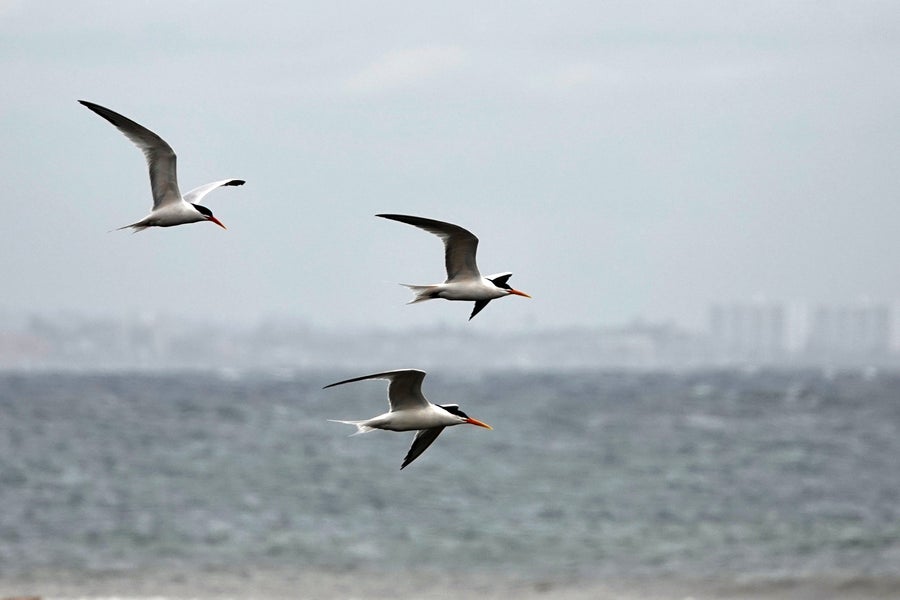
Elegant Terns fly over Malibu Lagoon State Beach.
Kate Wong
I was reminded of how fortunate I am to be birding in these times on a recent work trip to Los Angeles. After an intense week of anthropology conferences, I had a couple days off before my flight home. My plan was to take a day trip to California’s Channel Islands to look for the Island Scrub-Jay, a species of jay that lives on Santa Cruz Island and nowhere else. But the day before my planned visit, the ferries out to the islands were canceled because of dangerously high winds. I had to come up with another plan. I already had a few other species on my wish list, including Wrentit, Heermann’s Gull, and Allen’s Hummingbird. And a friend suggested I might like to see the Yellow-billed Magpie, which I fell in love with as soon as I looked it up in the Sibley Birds app on my phone. I wondered how many of these birds I could reasonably hope to find.
I thought back to a story I wrote a few years ago on competitive birding, in which participants in a “Big Day” contest raced to find as many species as they could in 24 hours. The team I followed for the story started preparing weeks before game day by scouting locations all over the state of Connecticut for birds and mining eBird data for other recent sightings of target species. It then devised driving routes that would allow the team members to visit as many of those locations as possible in the competition period. I wasn’t attempting a Big Day in California, but I had only a little time to bird, so I decided to take inspiration from the team’s logistical planning.
I started poking around on eBird to see where other people had spotted my target species in the past couple days and mark their locations on Google Maps. The bird that was going to be the hardest to get was the Yellow-billed Magpie, which has a very restricted range in central California. Of course that was the bird I wanted most. It looked like if I were to drive a bit northwest of Santa Barbara, I had a decent shot at getting it in the southernmost part of its normal range. I planned a route that allowed me to search for as many of my target species as possible between L.A. and Santa Barbara County. I tried to make sure I had backup spots for the birds I wanted most, in case the first spot didn’t pan out. And then I hit the road.
At Malibu Lagoon State Beach, I stood to pick up several new-to-me species of gulls, terns and shorebirds, including Heermann’s Gull, Elegant Tern and Snowy Plover. The lagoon was brimming with birds—hundreds of enormous Brown Pelicans roosted on the sandbar, preening their feathers with their impossibly long bills; Northern Shovelers, Gadwalls and a host of other ducks patrolled the shallow water; and gulls and terns were everywhere, including some odd dark brown gulls. I started to scan the gulls and terns for my targets, but they were mostly too distant for me to see well enough with my binoculars to identify them. The couple next to me on the viewing platform overlooking the lagoon was happy to show me the terns through their spotting scope, with its much stronger magnification. They pointed out the differences between Royal Terns, with their thicker bill and smooth black cap, and Elegant Terns, with their thinner bill, shaggy crest and shell-pink breast feathers. And the chocolate brown gulls I’d been struggling to identify turned out to be young Heermann’s Gulls that hadn’t yet developed their striking ombré-effect adult plumage, with a white head, pale gray neck and chest, and slate-colored back and legs—a stormy sky in bird form.
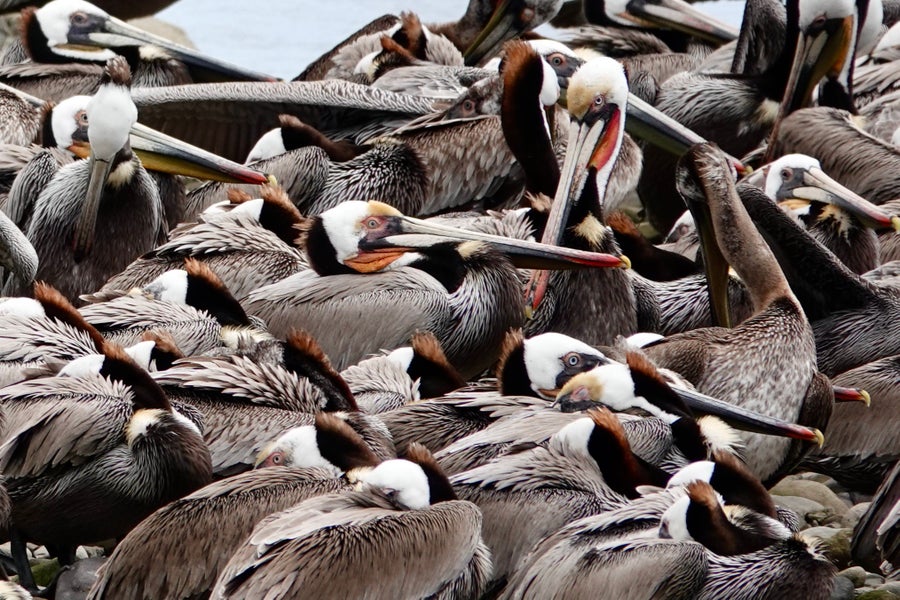
Brown Pelicans roost at Malibu Lagoon State Beach.
Kate Wong
A boy lugging a giant camera approached us on the platform, accompanied by his father. The boy asked if we had seen the Black-legged Kittiwake, a type of gull, that had recently been reported on eBird at this location—a rare offshore visitor blown in by the strong west winds. We hadn’t. Ah, well. He’d just seen 16 Snowy Plovers on the beach, he informed us. We walked out toward the water’s edge with our young guide to look for them and, after much searching, spied several of the little round shorebirds camouflaged against the sand, seaweed and driftwood.
At Point Dume, a promontory in Malibu with sensational views of Santa Monica Bay and the rugged California coast, the howling winds that canceled my ferry to the Channel Islands also kept many birds out of sight as they took cover in vegetation. But when I descended the stairs between the clifftop and the beach below, I was able to get out of the wind and see some birds flitting around in the scrub growing on the cliff face. A small gray bird with a big head and piercing pale eyes popped out of a lemonade berry shrub (plant ID courtesy of iNaturalist) and gave me a curious once-over. Its long, wrenlike tail and small, chickadee-like bill clicked in my brain: Wrentit! (Tit is a British word for chickadee.) I admired the bird as it foraged for bugs among the shrub’s pink blooms, delighted to get such a good look at this notoriously skulky species.
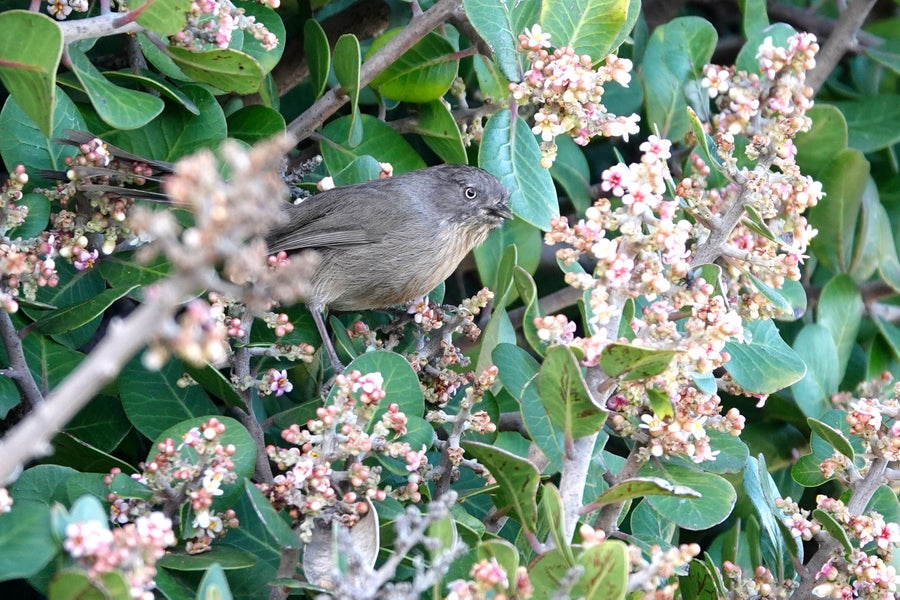
Wrentit forages at Point Dume.
Kate Wong
The next morning it was time to look for the magpie, my top priority. I set off from my hotel in Santa Barbara and drove to a country road 45 minutes away in Los Olivos, where the species had been reported by multiple birders on eBird in the past week. A few minutes out from my first planned stop, I heard an unfamiliar bird call and remembered that although I knew what the magpie looked like, I hadn’t yet learned the bird’s calls and songs. I had my search image in mind but not my search sound. I pulled over to park under the shade of an old oak and opened the Sibley app on my phone, one of several birding ID apps that provide audio recordings of bird species in addition to images. As I listened to the calls, I realized that the unfamiliar sound I’d heard moments ago was a match. I rolled down my window to listen again and opened the Merlin app, which can identify birds based on their vocalizations: Yellow-billed Magpie, the app confirmed. I grabbed my binoculars and hopped out of the car to look for my most wanted bird, heart racing as I surveyed the vineyard across the road. It didn’t take long for the magpie to reveal itself with a raucous squawk and a flash of black, white and iridescent blue feathers as it rummaged for insects among the gnarled grape vines with its stout, banana-colored bill.
As I observed the magpie, thrilled to find my treasure, I realized I could hear another magpie behind me. Suddenly the bird I was watching took off and flew across the road to the oak I had parked under. Peering up into the tree, I saw both magpies together, the male feeding the female in a courtship ritual before the pair turned their attention to the nest they were building on one of the oak’s high limbs. I love seeing animals engage in classic behaviors such as this—it’s comforting to know that even when so many things in the world are terrible, the birds are still flirting, constructing their nests with care and preparing to raise the next generation. I marked the location of the nesting magpies in eBird for any other birders who might like to see them.
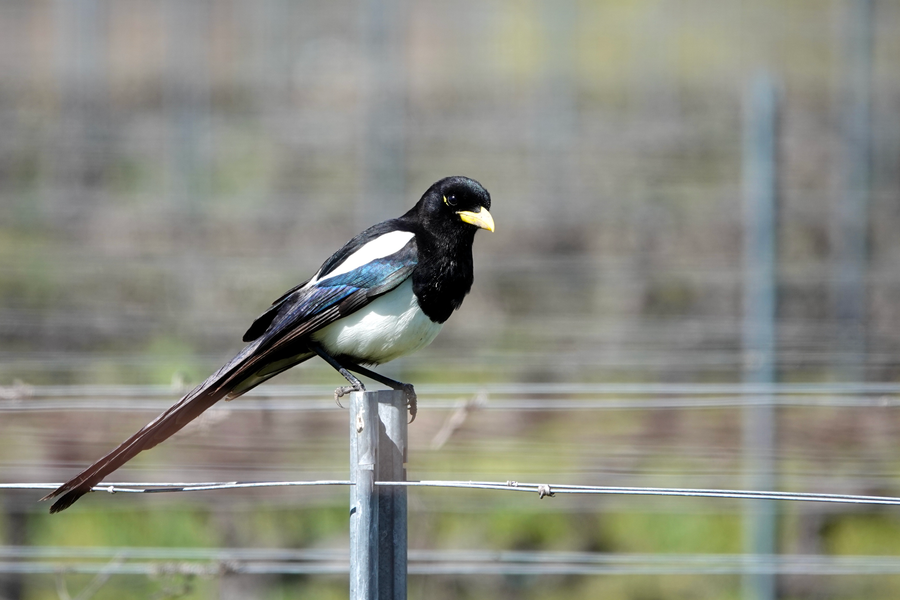
Yellow-billed Magpie perches on a vineyard post.
Kate Wong
I didn’t find all of the birds on my target list. In fact, I missed quite a few. But that’s okay—the birds I saw were fantastic. Of course, I could have just gone birding anywhere without any forethought and enjoyed whatever happened to be around. Nothing wrong with that! But it was so satisfying to make a strategic plan to look for specific species I wanted to see—and then actually find them in those places.
Back home on the East Coast, I’m using these same tools to make the most of migration. Every night I look at BirdCast, a project by the Cornell Lab of Ornithology, Colorado State University and the University of Massachusetts Amherst, which predicts and tracks the movement of birds across the continental U.S. during migrations and even tells you which species are likely to be on the move on any given night. Right now, it tells me, Yellow Warblers, Blue-gray Gnatcatchers and Rose-breasted Grosbeaks are among the nocturnal migrants most likely to be arriving or departing my area. I’ll keep an eye—and an ear—out for them on my birding excursions. When there’s an especially big movement of birds, I’ll make an extra effort to go birding the next morning before work if I can and look for new arrivals. I may consult the Windy app, which predicts wind and weather conditions 10 days out. If I want to bird a coastal spot, I can plan for the best tides for that location using a tide app. (I use Tide Alert.)
Finding a rare bird is super fun—and all the more rewarding if you’re able to help other folks see it, too. In the old days, my birding friends who have been at this game for a long time tell me, people relied on phone trees to get the word out about rarities; each person in the tree would call two people to spread the news. Or people would call hotlines to hear a prerecorded list of rare birds that had been reported in the last week. These days, birders in my home state and many others share sightings and locations of rare birds instantly using the group texting app GroupMe or other messaging apps such as WhatsApp and Discord. Reporting a rarity quickly is really helpful because birds are creatures with agendas all their own. A bird that shows up one day may well move on by the next. I was the beneficiary of just such a notification a few days ago, when a GroupMe alert about a Kentucky Warbler came through, allowing me and many others to enjoy this stunning bird as it hunted for insects in the leaf litter of a nearby preserve.
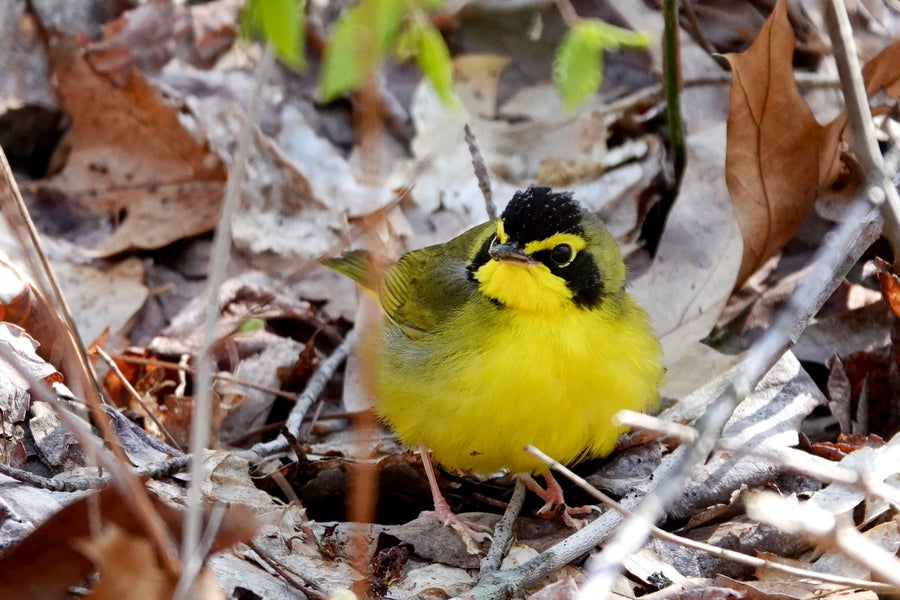
Kentucky Warbler hunts for insects in the leaf litter.
Kate Wong
These tools have their limitations. Merlin’s sound identification feature, for instance, sometimes serves up identifications that are extremely unlikely, if not impossible. I don’t know what it was keying off of the times it told me that it heard a Red-whiskered Bulbul from Asia in Connecticut or a Ring Ouzel from Europe in California, but I’m pretty sure it was wrong. (If it wasn’t, I’m going to have a lot of birders in these places upset with me for not reporting some mega-rarities.) My favorite way to use Merlin is to have it listen to the birds in a place that I’m visiting for the first time so that I can look at the results and then search for those species in that location. If Merlin says it heard a bird that is unexpected for that place and time, I won’t count it unless I actually see it. And sometimes I’ll use it to quiz myself: I’ll listen to the bird songs and calls around me and see how my own identifications compare with the IDs that Merlin provides. Not so long ago pretty much the only way most people could learn bird vocalizations was to go out in the field and study them there. Having recordings of these sounds on my phone has greatly accelerated the learning process for me.
I’d be remiss if I didn’t acknowledge that birds around the world are in a state of dramatic decline because of climate change and habitat loss from human activity. In 2022 researchers estimated that the North American bird population had lost nearly three billion breeding adults since 1970. But this grim fact only underscores the value of watching birds—of bearing witness to their plight even as we enjoy them and taking action where we can to ensure a brighter future for these vital, marvelous animals. There’s never been a better—or more important—time to become a birder. See you out there?

